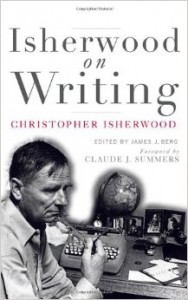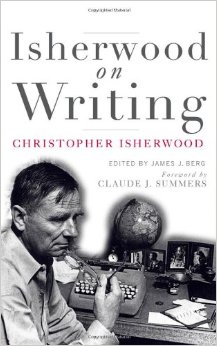 Isherwood on Writing: The Lectures in California
Isherwood on Writing: The Lectures in California
Edited by James J. Berg
University of Minnesota Press. 208 pages, $25.95
ON MARCH 20, 1959, Christopher Isherwood signed on to teach at Los Angeles State College. This turned out to be the first of three campuses where he would lecture over the next seven years. He also taught at UC–Santa Barbara in 1960 and at UCLA, 1965–66, and he delivered two lectures at UC–Berkeley. Isherwood scholars and fans have long been aware that transcripts exist of the lectures he delivered at the two UC campuses; now these transcripts, along with lectures notes, have been published.
Isherwood on Writing is divided into three sections. The first consists of a series called “A Writer and His World,” the name he gave to his Santa Barbara lectures. The second, “The Autobiography of My Books,” contains his UCLA and Berkeley lectures. The third consists of Isherwood’s lecture notes. Those who have read some of the novelist’s many interviews will find many familiar themes here. As in his interviews, Isherwood pays homage to his favorite writers—Melville, Hemingway, Dostoevsky, Tolstoy, Lawrence, Conrad, Katherine Mansfield, R. L. Stevenson, and especially E. M. Forster—and explains why he’s partial to them. The one visual artist who finds a prominent place is Francis Bacon, who tried to “get down to the nerve” in his paintings. Isherwood’s ideal writer is one who possesses this quality, who relies on his own experiences in his work, and one who strives to communicate a sense of “joy.” The latter notion apparently derives from his reading of Vedantic literature. In one lecture he quotes from the Taittarya Upanishad—although he doesn’t acknowledge the source—to explain his idea of joy as “a kind of higher fun, a kind of mad vitality which exists in the universe.”
Related to this “higher fun” is the premium Isherwood places on comedy. He is generous in his admiration of comic writers and obviously likes to think of himself as one. His sense of the comic includes the idea of performance, whether on stage or on screen—or in a university classroom. As biographer Peter Parker shows us, Isherwood considered his UC lectures “a smashing success,” not because of their content but because of the style in which they were delivered. He talks at great length about his collaborations with Auden and about his experiences with the Austrian film director Berthold Viertel who inspired the character of Friedrich Bergmann in Prater Violet. Performance is of such importance to him because of the great store he sets by objectivity. This desire to escape the ego is something that’s encouraged by Vedanta. It is curious how well the Hindu philosophy dovetails with Isherwood’s pre-Vedantic poetics. It is this same desire for objectivity that he uses to explain his preference for the typewriter: “because my handwriting is too intimate.”
But this volume is interesting not because of what Isherwood says but also because of what he doesn’t say. Toward the end of one lecture he talks about his visit to war-time China as “incomparably one of the most interesting experiences of my life,” but devotes only a short paragraph to it in a subsequent lecture. He uses the Sanskrit word tamas in his lecture notes to expand on his idea of sloth but refrains from using the word in the actual lecture. In his notes for the lecture entitled “A Writer and Religion,” his final line is: “But the best is to keep to biography: Ramakrishna.” Ramakrishna is nowhere mentioned in the lecture itself. Could this be because he was worried that talking too much about the Orient would alienate his audience?
Could this same worry explain his pussy-footing around the topic of homosexuality? His discomfiture when talking about the bisexuality of Stephen Monk in The World in the Evening, for example, reminds us that Stonewall was still a decade in the future. He did state, however artfully: “I am opposed to those laws which interfere with [an adult’s]sexual life.” For all his obliqueness here, as Claude J. Summers points out in his wonderful foreword, there may well have been many in the audience who could decode these words to find a call for gay rights.
The frank representation of homosexuality in Isherwood’s fiction and autobiography earned him an unimpeachable position of eminence rose, if you will, in 1960’s and 70’s. Interest in his life and work shows no sign of ebbing even after the publication of two volumes of his journals—which have not always shown him in a particularly flattering light. A section of the Isherwood following believes that the best of Isherwood is already in print, but there are others who believe that anything he didn’t burn should be published, irrespective of the work’s literary merit. Although Isherwood had refused to publish these lectures when offered by UC–Santa Barbara, dismissing the speeches as “just silly, or worse, coy,” one is grateful for their publication, because this book brings home how profoundly a spiritual exercise writing was to Isherwood, and how joyful a one.
__________________________________________________________________
Niladri Chatterjee is a senior lecturer in the Dept. of English at the University of Kalyani, India.






